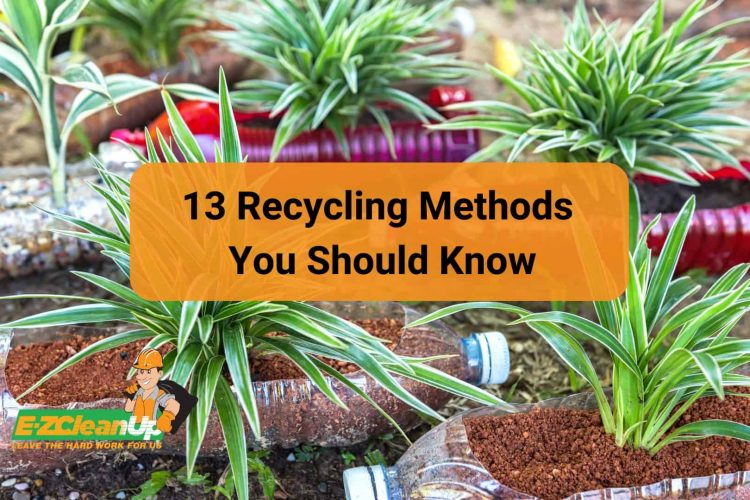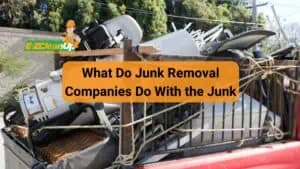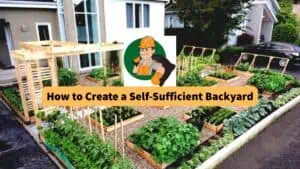Explore recycling methods, such as covering materials from paper to plastics and metals to electronics. Learn the processes for handling glass, textiles, and hazardous waste, along with approaches in automotive and food waste recycling, to enhance sustainability and resource conservation.
Learn the details of the 13 recycling methods you should know in our guide below.

#1: Paper Recycling
Recycling paper and cardboard starts by sorting materials like office paper and cardboard to remove any non-recyclable parts. Next, these sorted materials undergo a pulping process where they are mixed with water and chemicals, breaking them down into fibers. This pulp is then cleaned to remove inks and adhesives.
De-inking follows, where the ink is removed to prepare the pulp for bleaching. This makes it suitable for producing brighter paper. The final steps involve draining the pulp, forming it into sheets through rollers, and then drying these sheets. These sheets are then ready to be turned into new paper products. This completes the recycling cycle.
#2: Glass Recycling
Recycling glass requires specific handling based on color and type due to their unique melting points and chemical compositions.
Colored glass like blue, brown, and green needs to be recycled separately to maintain quality. Blue glass, often used for drinks, and brown and green glasses, which protect their contents from light, must not be mixed with clear glass.
Glass Recycling Steps:
- Collection and Transportation: Gather glass from various locations and transport it to recycling centers.
- Sorting: Sort the glass by color and type, which is crucial for quality control and effective recycling.
- Breaking and Pulverization: Break the sorted glass into smaller pieces, then refine these for use as cullet, the raw material for new glass.
- Final Screening and Quality Control: Screen the glass to ensure the correct size and remove any impurities. Make sure the cullet is ready for new production.
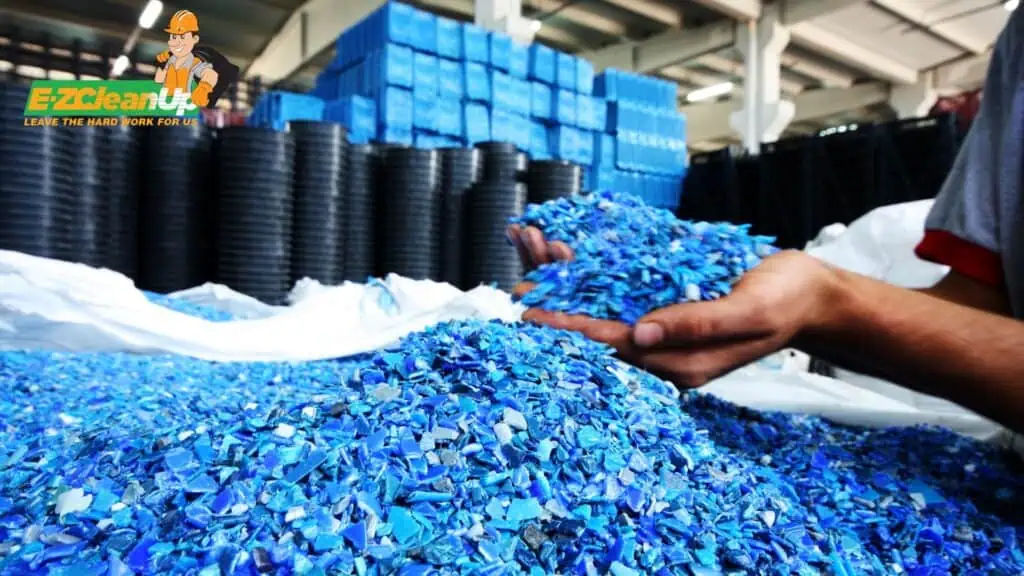
#3: Plastic Recycling
Resin Identification Codes, introduced in 1988 and standardized by ASTM International, play a crucial role in sorting plastics for recycling. These codes range from 1 to 7, each representing a different type of plastic resin found in various products.
Common Plastics and Recycling Methods:
- PET (Code 1): Used in drink bottles and food containers, commonly accepted in recycling programs
- HDPE (Code 2): Found in jugs and detergent bottles, widely recycled
- PVC (Code 3): Used in pipes and some packaging, less commonly recycled
- LDPE (Code 4): Includes bags and wraps, often recycled at specific drop-off points
- PP (Code 5): Found in yogurt containers and caps, recycling availability varies
- PS (Code 6): Known as Styrofoam, used in disposables with limited recycling
- Others (Code 7): Includes bioplastics and composites, generally hard to recycle
Modernization of RICs
Updates to the RIC system are underway to make it more user-friendly. This includes changing symbols to reduce confusion about recyclability—shifting from recycling arrows to a triangle indicates these codes are for identification, not necessarily recyclable everywhere.
Knowing these codes helps in proper sorting and enhances recycling efficiency, but it’s essential to check local guidelines as not all coded plastics are recyclable in all locations.
#4: Metal Recycling
Recycling metals such as aluminum and steel is essential for both economic and environmental reasons. These metals are collected as scrap, sorted, cleaned, and melted down to form new products. This process conserves raw materials, cuts down energy use, and reduces emissions.
Key Points in Scrap Metal Recycling
- Technological Improvements: Modern technologies like automated sorting and X-ray fluorescence analyzers help in efficient metal sorting and recycling.
- Market Factors: The value of scrap metal depends on market demand and material purity. Staying updated with market prices is crucial for recyclers.
- Environmental Standards: Recycling facilities must comply with strict environmental regulations to prevent pollution and protect ecosystems.
Recycling metals supplies cheaper raw materials while helping conserve natural resources and reduce environmental impact.
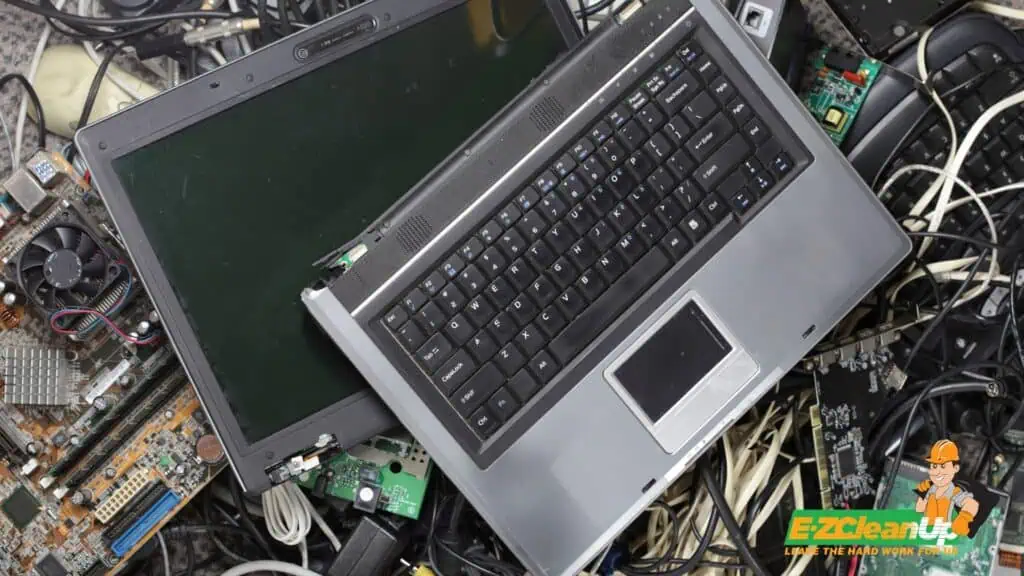
#5: Electronics Recycling (E-Waste)
Recycling electronics involves sorting them, dismantling them safely to retrieve valuable materials like metals and plastics, and then repurposing these materials into new products.
- Data Security: Ensuring the destruction of personal data on electronic devices is crucial to avoiding data breaches.
- Certification: It’s important to use certified recycling facilities that meet environmental and health standards.
Recycling helps conserve resources and prevent hazardous substances in electronics from harming the environment. Many manufacturers and retailers also offer take-back programs for responsible recycling.
#6: Battery Recycling
Battery recycling is vital for environmental safety and resource conservation. Batteries are sorted by type, then processed to recover valuable materials and handle hazardous substances.
Techniques Used
- Mechanical Shredding: Breaks down batteries to recover materials
- Hydrometallurgical Processes: Uses chemical solutions to extract valuable metals like cobalt and lithium
- Direct Recycling: Maintains the structure of battery components for reuse in new batteries
Choosing the right recycling method is crucial, depending on economic and environmental factors. By participating in battery recycling, consumers help close the resource loop and promote sustainability.

#7: Textile Recycling
Textile recycling starts with collecting and sorting textiles by type and condition, and then determining the recycling method to be used.
- Mechanical Recycling: For natural fibers like cotton, textiles are shredded and spun into new yarn.
- Chemical Recycling: Synthetic fibers are broken down chemically and remade into new fibers.
Despite challenges like the need for advanced technology and infrastructure, ongoing innovations are enhancing the effectiveness of textile recycling.
#8: Composting
Composting turns kitchen scraps and yard waste into valuable soil enhancers. It improves soil quality and supports plant growth. Here’s how to do it:
- Collection: Start by gathering organic waste like vegetable peels, coffee grounds, and lawn debris.
- Layering: Alternate between nitrogen-rich greens (like vegetable scraps) and carbon-rich browns (like dried leaves) to balance nutrients.
- Maintenance: Stir the pile regularly to introduce air, which speeds up decomposition and reduces smell.
- Maturation: Let the pile sit for a few months. During this time, microorganisms transform the waste into nutrient-rich humus.
Composting decreases the amount of garbage sent to landfills, which helps reduce methane emissions. Incorporating it into your daily routine is a proactive way to make a positive impact on the environment and promote sustainable living.
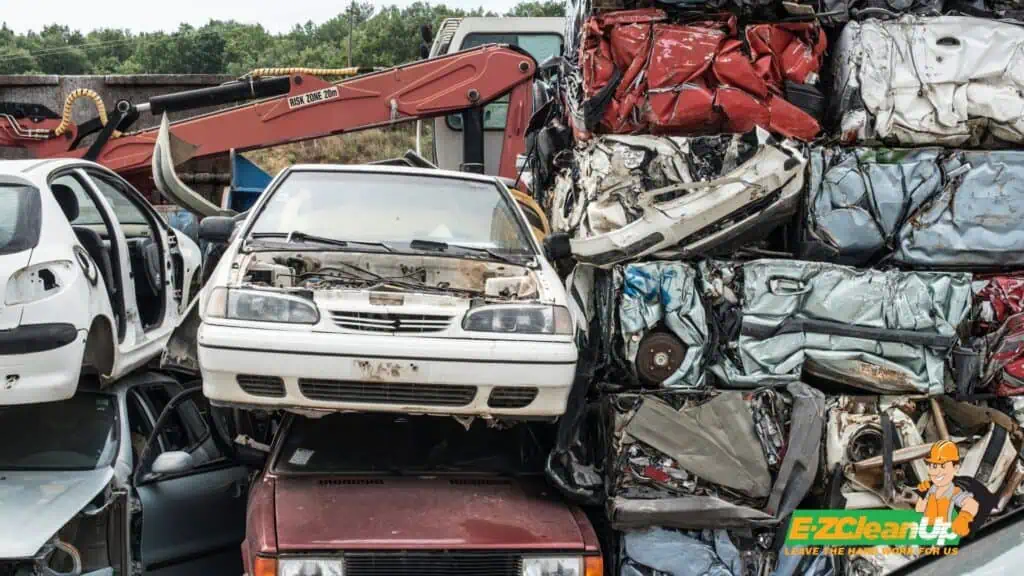
#9: Automotive Recycling
Recycling cars focuses on reusing metals and safely handling vehicle fluids. This process conserves resources and energy—recycling metals uses 74% less energy than producing new metals from ore.
Recycling facilities use cutting-edge methods to dismantle vehicles and salvage usable materials, from metals to fluids like antifreeze and brake fluid. This supports the circular economy by putting recycled materials back into use. It also creates jobs and reduces production costs.
The main problems in car recycling include separating mixed materials and managing non-metallic waste, known as auto shredder residue (ASR). Ongoing technological advancements are improving the efficiency of these processes. These will ensure that more materials are recycled and less waste is generated.
If you want to get rid of your non-functional car, EZ CleanUp pays cash for junk cars, regardless of their condition. This is a good way to earn some while freeing up space in your yard or garage.
#10: Construction Material Recycling
Recycling materials from construction and demolition starts with designing buildings for easy disassembly. It uses modular parts that can be easily taken apart and reused.
This method prioritizes mechanical fasteners like screws over adhesives to simplify the reuse of materials such as wood, metal, and glass.
There’s significant potential to reuse construction materials directly on-site. For instance, crushed concrete can be reused as aggregate, and old wood can be repurposed for new building parts or decorative elements.
Effective recycling needs careful planning and coordination with recycling facilities to ensure materials are correctly sorted and processed.

#11: Furniture Recycling
Recycling old furniture involves several important steps that help extend its life and reduce its environmental impact:
- Disassembly and Material Separation: Break down furniture into materials like wood, metal, and fabric. This allows for specialized recycling processes.
- Refurbishing: Repair and upgrade old furniture through sanding, painting, and reupholstering.
- Repurposing: Creatively adapt furniture for new uses, such as turning a dresser into shelving or a table into a desk, which prolongs its life and reduces waste.
Benefits of Recycling Furniture
Furniture recycling brings several advantages:
- Environmental Impact: It reduces landfill waste, decreases the demand for new raw materials, and conserves natural resources.
- Economic and Social Benefits: Creates jobs in recycling and refurbishment, offers affordable furnishing options, and supports charities through donated furniture
- Innovation and Design: Leads to unique, custom furniture pieces that reflect personal style and encourage sustainable living
#12: Food Waste Recycling
Urban areas offer unique methods for efficiently recycling food waste:
- Community Composting: Local programs allow residents to contribute organic waste.
- Behavioral Interventions: Campaigns that educate and encourage proper recycling habits can significantly boost recycling efforts. These are done using techniques that highlight the environmental benefits and provide clear instructions.
Advantages of Recycling Food Waste
Recycling food waste in cities has several key benefits:
- Reduces Greenhouse Gases: Keeps food waste out of landfills where it would produce methane, a potent greenhouse gas.
- Produces Valuable Products: Processes like anaerobic digestion turn food waste into biogas and biofertilizers. They enhance renewable energy production and improve soil health.
- Saves Resources: Lowers the demand for traditional waste disposal methods, conserves energy and eases the burden on waste management systems.
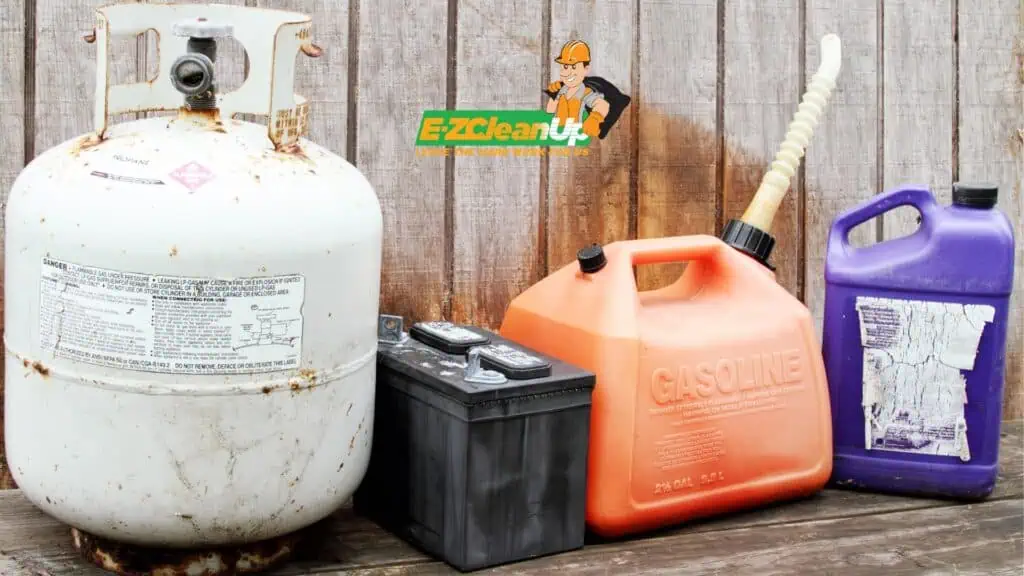
#13: Specialty Material Recycling
Recycling unusual materials like rubber and hazardous waste presents challenges but also opens up opportunities for innovation.
Rubber is recycled using methods like mechanical grinding or cryogenic fragmentation. These allow the material to be repurposed for uses such as paving or making new rubber items.
Hazardous waste recycling, however, must strictly follow safety regulations to prevent environmental harm. This includes safely reclaiming materials such as used oils and specific metals under controlled conditions.
Overcoming Challenges with Innovative Recycling Techniques
The recycling of hazardous materials requires careful navigation of strict regulations to ensure safety and environmental protection. For example, only certain byproducts from industrial processes can be reused if they are confirmed to be non-hazardous.
Advances in recycling technology improve the safety and efficiency of processes that transform hazardous waste into valuable materials. These innovations include new treatment technologies that recover useful components from hazardous waste. These can turn potential pollutants into valuable resources for various industries.
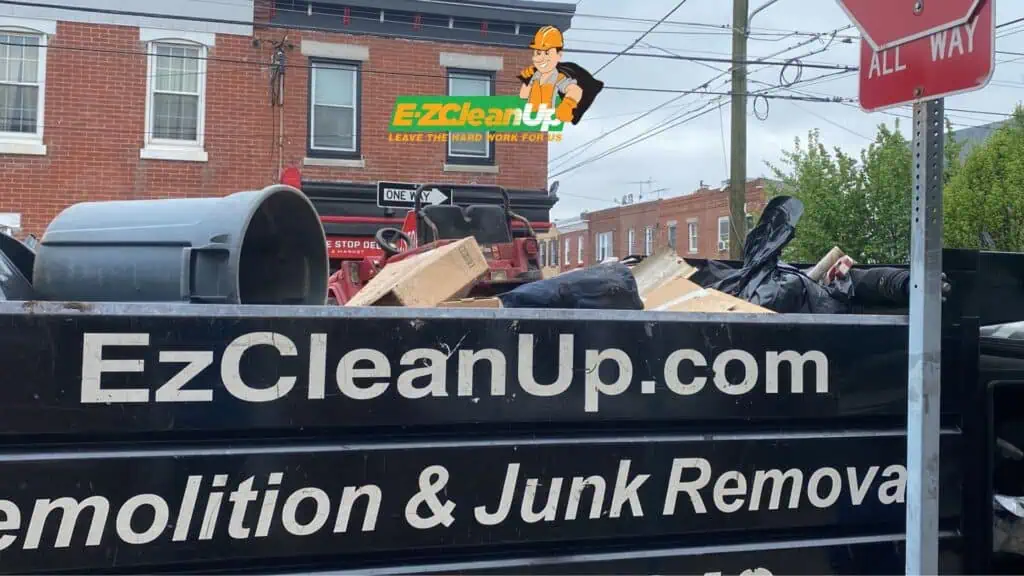
EZ Does It: Your Partner in Efficient Recycling
Every type of recycling needs careful handling to work well. EZ CleanUp offers expert services to help you collect, sort, and recycle different materials. We make it easier for you to be eco-friendly.
By working with us, you can be sure your recyclables are dealt with properly. Contact us to simplify your recycling projects.

